| Author: | |
| Website: | |
| Page title: | |
| URL: | |
| Published: | |
| Last revised: | |
| Accessed: |
The Internet is a vast network of networks that spans the entire globe. Data is transferred from computer to computer, and from network to network, using packet-switching technology and a suite of Internet protocols called TCP/IP, after its two most important protocols.
Although only popularised in the 1990s, the events that were to lead ultimately to the creation of the Internet started back in the late 1950s. When the Soviet Union launched the first earth-orbiting satellite (Sputnik) in 1957, the United States awoke to the fact that they were being overtaken in the space race. One of the results of this realisation was the establishment of the Advanced Research Projects Agency (ARPA) in 1958. In 1969, ARPA set up a research project called ARPANET (Advanced Research Projects Agency Network) to create a secure, de-centralised network capable of functioning when parts of the network infrastructure were destroyed or disabled (for example, in the event of a nuclear war).
The idea behind packet-switching was to break messages down into small blocks of data called packets that could be sent across a network independently of one another, and if necessary via different routes. The message would be reassembled by the receiver once all of the packets had arrived safely. If a packet was lost or damaged, it could be re-transmitted, avoiding the need to re-transmit the entire message from the beginning. The protocols used to transfer data across the network had to be robust and flexible enough to be able to deal with lost or damaged packets and adapt to the sudden loss of network links by finding a new route between the two communicating end points. The protocols also had to work over a number of different underlying network technologies, and on different operating systems and hardware platforms.
The first standard networking protocol developed for ARPANET was the Network Control Protocol (NCP), which was deployed in December 1970 and successfully used by a number of ARPANET sites to communicate with each other in October of the following year. By the end of 1971 there were fifteen sites using NCP. They consisted mainly of universities and scientific research centres, and included Carnegie Mellon University, Harvard University, MIT, the RAND Corporation, Stanford University, and UCLA.
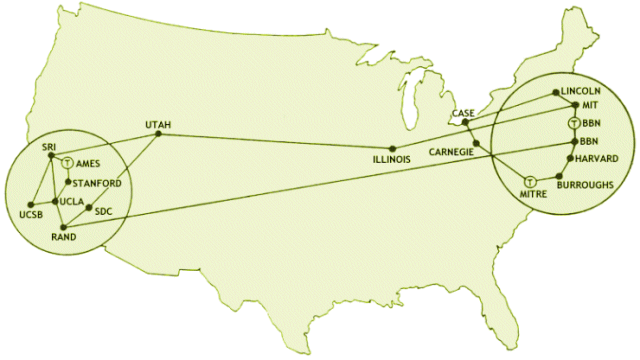
ARPANET, October 1971
By July of 1975, ARPANET was an operational network, and the period from 1973 to 1982 saw the development and refinement of the TCP/IP protocol suite, and its implementation on a range of operating systems. The developing Internet technology attracted the attention of the US military, and in 1978 it was decided that the TCP/IP protocols would be adopted for military communications. ARPANET became the world's first TCP/IP-based wide area network in January 1983, when all ARPANET hosts were switched from NCP to the new Internet protocols.
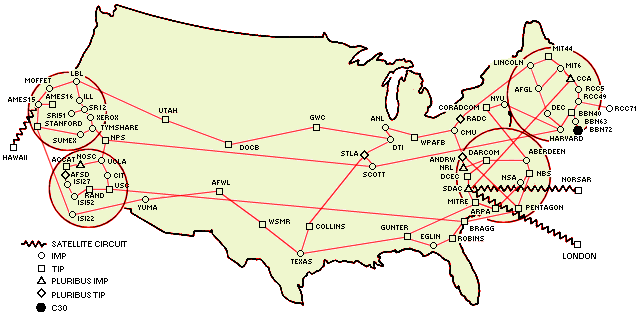
ARPANET, September 1980
During the 1970s and 1980s, the evolving network was used primarily by academics, scientists and the US government for research and communications, but all that changed in 1992, when the US Department of Defense withdrew funding from the ARPANET project, having essentially achieved their objectives. In 1985, the US National Science Foundation (NSF) had commissioned NSFNET, a 56 kilobits per second university network backbone, which was upgraded to T1 bandwidth (1.544 Megabits per second) the following year due to high demand. 1989 saw NSFNET linked with the commercial MCI Mail network, and other electronic mail services, including Compuserve, were quick to follow suit. 1989 also saw the emergence of three commercial Internet service providers (ISPs) - UUNET, PSINET and CERFNET.
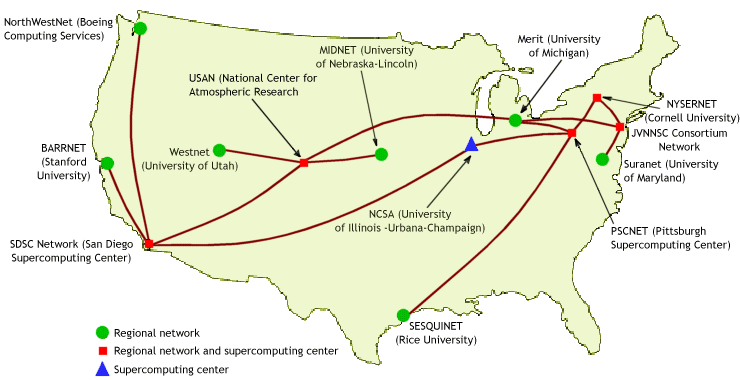
NSFNET T1 backbone map, 1988
Other networks, notably Usenet and BITNET at first offered gateways into the Internet, and later merged with it. Soon, more commercial and educational networks, such as Telenet, Tymnet and JANET were interconnected with the Internet. The rapid growth of the network was facilitated by the availability of commercial routers from companies such as Cisco Systems, a sharp increase in the number of Ethernet-based local area networks, and the popularity of the Berkeley Software Distribution (BSD) of the UNIX operating system, which included the TCP/IP protocols.
In 1989 Tim Berners-Lee, a computer scientist working at the CERN laboratories in Switzerland, developed the hypertext-based information system that was to become the World Wide Web. The Web was at first used, like the Internet itself, only by academics and scientists. When the military closed down the ARPANET in 1992, however, a number of commercial organisations offered Internet access to the general public for the first time. 1993 saw another milestone as the National Centre for Supercomputing Applications (NCSA), based at the University of Illinois, released the Mosaic Web browser. The significance of this development was that his was the first Web browser to offer a user-friendly, graphical user interface that could display graphic images as well as text. By 1994, there was growing public interest in the Internet, and by 1996 use of the term "Internet" had become commonplace.
During the course of the 1990s, most of the remaining public computer networks were linked to the Internet, and became part of it by definition. The size of the Internet is estimated to have approximately doubled each year during this decade, with the most dramatic growth occurring during 1996-1997. Many factors encouraged such growth, among them the non-proprietary and open nature of the Internet protocols which facilitated the interoperability of both hardware and software from different vendors, the lack of any significant centralised control, and the fact that no one organisation actually owned the Internet. The internet today is a globally distributed network of interconnected networks, consisting of high-capacity backbone networks, regional networks, commercial networks and local area networks, as well as the millions of home computers, mobile phones and other personal computing devices connected to the internet via a service provider's network.
Below is a graphic representation of the Internet circa 2003, showing the links between Internet routers. If nothing else, it serves to illustrate the sheer complexity of this vast network of networks.
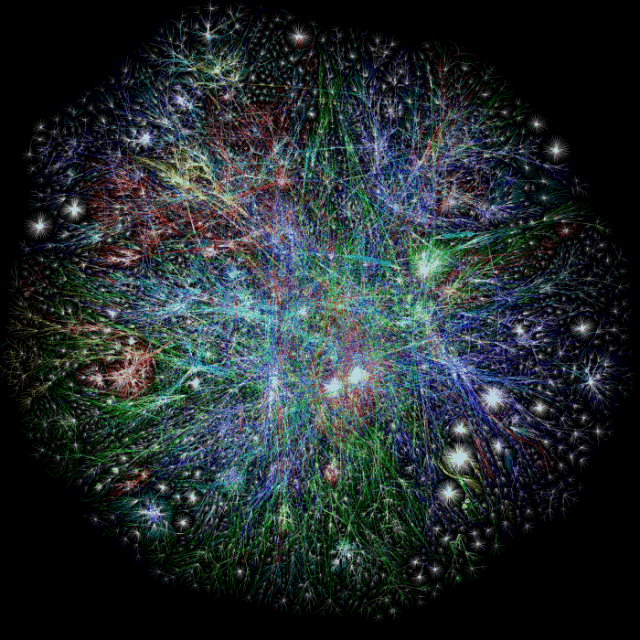
Connections between Internet routers, circa 2003
According to recent statistics, the Internet had 1.463 billion users worldwide as of June 30th, 2008. This represents a thousand-fold increase in the last fifteen years, largely attributable to the widespread availability of low-cost computers and Internet access, the almost universal adoption of computer and networking technology by commerce, industry and mainstream education, and the phenomenal growth in commercial Internet services and new Internet technologies.
All research councils, universities and FE colleges in the UK are connected to the UK's government-funded national research and education network (NREN). The network is called JANET (Joint Academic NETwork), and is linked to other NRENs in Europe and around the World via GEANT, Europe?s main research and education network.
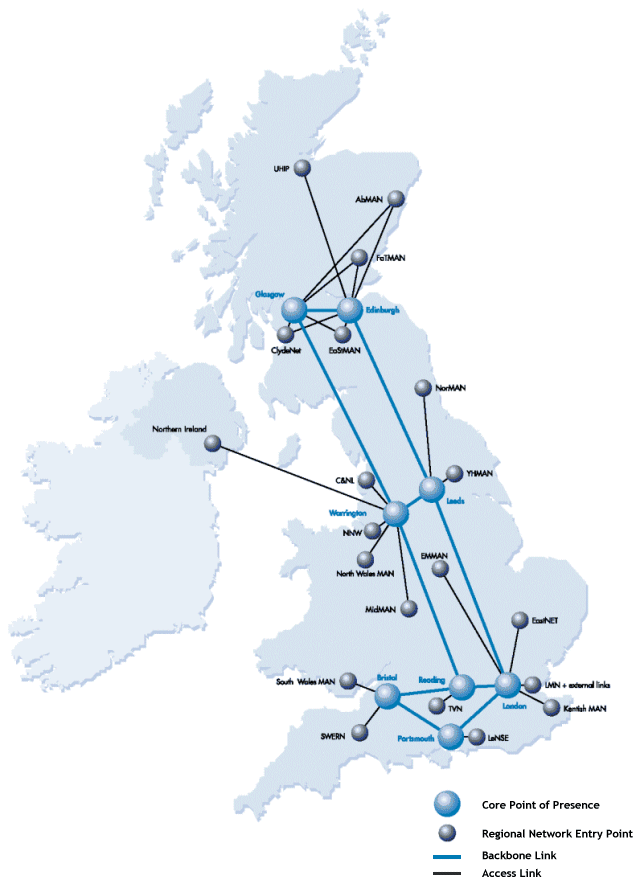
The backbone of the UK academic and research network (JANET), 2001
The South West England Regional Network (SWERN) connects the Universities of Plymouth, Exeter, Bristol, Bath, Gloucestershire and the West of England and provides connections for many other HE institutions and FE colleges in the region.
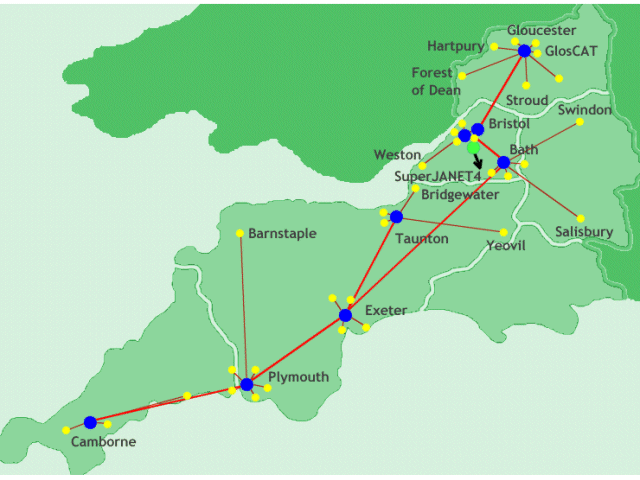
The South West England Regional Network (SWERN)
The growth of public interest in and use of the Internet has been given further impetus since the mid 1990s thanks to increasingly powerful computers, user-friendly desktop operating systems, a rapid and continuing increase in connection bandwidth, and the availability of a vast range of online services. At the same time, the cost of both computer hardware and broadband Internet connections has fallen dramatically. In addition to the many Internet cafés, the Internet can be accessed from public libraries, community centres and other publicly accessible institutions free of charge, which means that even those with limited means can gain access to information services, provided they have a modicum of computer literacy.
The Internet has changed the way we communicate. Electronic mail, although predating the Internet, is now available to both businesses and private individuals, and allows us to send text information and file attachments to anyone, anywhere in the world, providing they have an Internet-enabled computer, PDA or mobile phone. Social interaction has been given a new dimension thanks to the advent of Internet Relay Chat (IRC), social networking Web sites such as Facebook and MySpace, and multi-player online gaming. Business people can talk to colleagues, customers and suppliers anywhere in the world using video conferencing. Even private long-distance and international telephone calls can now be conducted using Voice Over IP (VOIP) technologies such as Skype, at a fraction of the cost of using conventional landlines, or even free of charge if both parties have an Internet connection, a computer, and a suitable headset or Internet phone.
Advances in mobile phone and wireless technology mean that even those on the move can now access the many services available via the World Wide Web in they have a 3G mobile phone, or a wireless-enabled PDA or laptop computer. Railway and bus stations, airports and ports, and many other public places (like McDonald?s!) now provide wireless access points (sometimes referred to as "hot spots"). Interestingly, there are more mobile phones with access to the Internet than there are computers, although due to the far higher cost involved, these facilities are still not widely used.
The Internet, and the many Web-based services available today, has changed the way we live and work, probably for ever. More of us are now able to work from home, or at least work far more flexibly, thanks to secure broadband Internet connections. We can shop online, bank online, and even renew our motor insurance, road tax and the TV license online. We can receive live Internet TV and radio broadcasts, download music and video, catch up with the news and sport, get a weather report, book a holiday, or even track down long lost friends, all online. Where will the Internet be in ten years time? I suspect it would be very foolish to make any predictions.